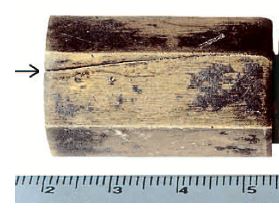|
|
|
|
• EC • Season Cracking • Caustic Embrittlement • SSC • LME • MIC • SCC • HB-HE-HIC • Fatigue • Erosion • Fretting • Stray Current • Index |
|
Different Types of
Corrosion
|
|
Liquid Metal Embrittlement |
|
|
Recognition of Liquid Metal Embrittlement |
|
|
What is liquid metal embrittlement? Liquid Metal Embrittlement (LME) refers to environmental cracking caused by contact with a liquid metal. It is also known or as Liquid Metal Cracking (LMC).
Mercury-containing items are prohibited by all airlines as they pose a real risk to the structural integrity of the aircraft which is made of aluminum alloys.
Zinc from galvanized steel parts or zinc-rich paints is frequently found to be responsible for the cracking of welded steel components in various industries.
|
|
|
Mechanisms of Liquid Metal Embrittlement |
|
|
What causes liquid metal cracking? The mechanism of liquid metal cracking is clearly not electrochemical in nature. It is most probably an adsorption-induced cracking. The liquid metal atoms when adsorbed on a susceptible metal or alloy reduces the metal bond strength within the grain boundary regions of the susceptible metal. Under tensile stress, crack initiates and propagates rapidly along the grain boundaries.
|
|
|
Prevention of Liquid Metal Embrittlement |
|
|
How to prevent liquid metal cracking? Liquid metal cracking can be prevented through:
|
|
|
For more details on Liquid Metal Embrittlement |
|
|
Where can I learn more about liquid metal embrittlement? More details on liquid metal cracking are included in the following corrosion courses which you can take as in-house training courses, course-on-demand, online courses or distance learning courses:
If you require corrosion expert witness or corrosion consulting service on liquid metal embrittlement (LME), our NACE certified Corrosion Specialist is able to help. Contact us for a quote. |
|
|
Home | Subject Index | Contact Us | PDF |
Copyright © 1995-2024. All rights reserved. |
 There is a specific combination of
There is a specific combination of